Performance Measurement Baseline: The Ultimate Guide to Project Success
Success is measured by more than just completion. Enter the Performance Measurement Baseline – your roadmap to project success. Understanding and implementing a Performance Measurement Baseline (PMB) can be the difference between a project that merely finishes and one that truly excels.
In this article, you’ll learn everything you need to know about Performance Measurement Baselines:
- What a PMB is and why it’s crucial for project success
- How to create a robust PMB step-by-step
- The integration of PMB with Earned Value Management (EVM)
- Advanced techniques for maintaining and updating your PMB
- Real-world applications across various industries
- Future trends in performance measurement
What is a Performance Measurement Baseline?
A Performance Measurement Baseline (PMB) is an integrated scope, schedule, and cost plan for project work. It serves as the foundation for measuring and reporting project performance throughout its lifecycle. In my years of working with companies like 3M, Dell, and GE, I’ve found that a solid PMB is the cornerstone of effective project tracking and control.
The PMB acts as a reference point, allowing project managers to compare actual progress against planned performance. It’s not just a static document; it’s a dynamic tool that evolves with your project, providing invaluable insights into project health and potential issues.
Components of a Performance Measurement Baseline (PMB)
A comprehensive PMB consists of three critical baselines:
- Scope Baseline: Defines what work needs to be done
- Schedule Baseline: Outlines when the work will be performed
- Cost Baseline: Determines the budget for completing the work
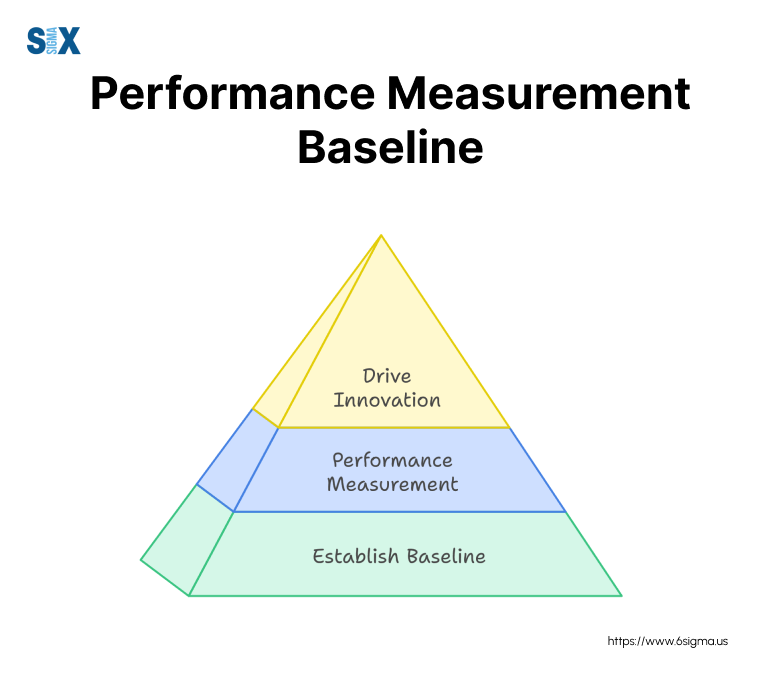
These three baselines work in tandem to create a holistic view of your project’s planned performance. In my experience leading Six Sigma deployments across various industries, I’ve seen how integrating these components can significantly enhance project visibility and control.
Performance Measurement Baseline (PMB) in the Context of Project Management
The Performance Measurement Baseline is intrinsically linked to the project management triangle of scope, time, and cost. It provides a structured approach to managing these three constraints, ensuring they remain in balance throughout the project lifecycle.
In the broader context of project management methodologies, the PMB aligns closely with both traditional and agile approaches. Whether you’re using PMBOK guidelines or Scrum frameworks, a well-constructed PMB can adapt to your chosen methodology, providing consistent performance measurement across diverse project environments.
Want to master the art of creating effective project baselines? Our Lean Six Sigma Green Belt course covers advanced project management techniques. Learn more and boost your project management skills today!
The Importance of Performance Measurement Baseline
I’ve seen the transformative power of a well-implemented Performance Measurement Baseline (PMB). It’s not just another project management tool; it’s a game-changer that can significantly elevate your project’s success rate.
Benefits of Using PMB (Performance Measurement Baseline)
- Improved Project Tracking and Control
A PMB provides a clear, quantifiable reference point against which you can measure your project’s progress. We implemented a PMB for a critical product development project. This allowed us to identify potential delays early, saving millions in potential overruns. - Enhanced Stakeholder Communication
The PMB serves as a common language between project teams and stakeholders. When I led a large-scale process improvement project, our PMB became the cornerstone of our communication strategy, ensuring everyone from executives to frontline workers understood our progress and challenges. - Better Decision-Making
With a PMB, you’re not flying blind. It provides data-driven insights that inform critical decisions. I recall a project where our PMB highlighted an unexpected cost trend, allowing us to pivot our strategy and ultimately exceed our project goals.
Performance Measurement Baseline vs. Traditional Project Management
While traditional project management often relies on gut feelings and reactive measures, the PMB approach offers a proactive, data-driven methodology.
What’s included in the performance measurement baseline? Unlike traditional methods, a PMB incorporates the scope, schedule, and cost baselines into a single, integrated plan. This holistic approach ensures that all aspects of the project are considered in performance evaluation.
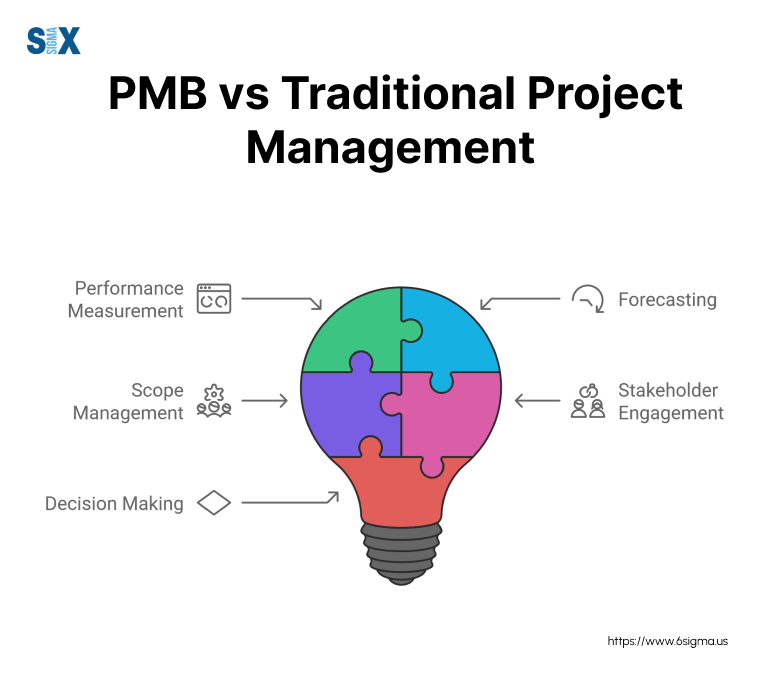
Struggling with scope creep and other project challenges? Our Root Cause Analysis course equips you with powerful tools to identify and solve the underlying causes of project issues.
Creating a Performance Measurement Baseline: Step-by-Step Guide
From my experience at 3M to consulting for companies like Dell and GE, I’ve refined this process into a step-by-step guide that’s both comprehensive and practical. Let’s dive into how to create a robust PMB that will set your project up for success.
Establishing the Scope Baseline
- Define project scope
Start by clearly articulating what your project aims to achieve. When I led a process improvement project at a consumer electronics manufacturer, we began by defining our scope as “reducing defect rates in chip manufacturing by 50% within 6 months”. - Create Work Breakdown Structure (WBS)
Break down your project into manageable components. I always emphasize the importance of a detailed WBS. For instance, in a software development project at a computer hardware and software manufacturer, our WBS included sections for design, coding, testing, and deployment, each with multiple sub-tasks. - Develop scope statement
Summarize your project’s objectives, deliverables, and constraints. This becomes your north star throughout the project lifecycle.
Developing the Schedule Baseline
- Identify activities and dependencies
List all tasks required to complete your project and determine their relationships. In my experience, this step often uncovers hidden complexities. - Estimate durations
Be realistic about how long each task will take. I’ve found that involving team members in this process improves accuracy and buy-in. - Create project schedule
Use your activity list and duration estimates to build a comprehensive schedule. Tools like Gantt charts are invaluable here.
Determining the Cost Baseline
- Estimate costs for each activity
Consider all resources required – labor, materials, equipment. During a project at Intel, we used historical data and expert judgment to refine our estimates. - Develop time-phased budget
Distribute your cost estimates over the project timeline. This gives you a clear picture of when resources will be needed.
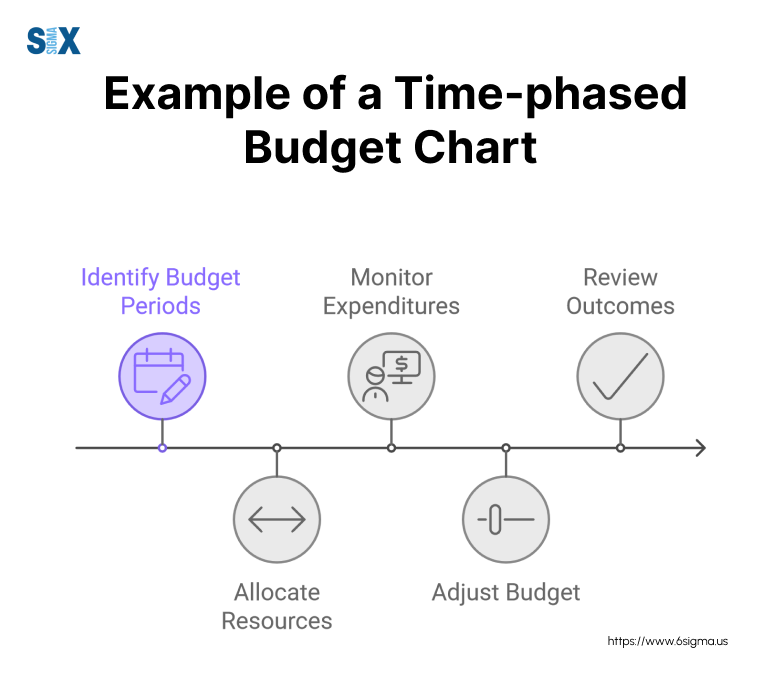
Integrating the Baselines
Combining scope, schedule, and cost baselines is where the magic happens. This integration is the essence of how to create a performance measurement baseline. Ensure alignment between these elements – each task in your WBS should have corresponding schedules and cost components.
Obtaining Approval and Baselining
- Review process with stakeholders
Present your integrated baseline to key stakeholders. In my workshops, I always stress the importance of this step for gaining support and identifying potential issues early. - Formal approval and sign-off
Once stakeholders are satisfied, obtain formal approval. This establishes your PMB as the official benchmark for project performance. - Saving the baseline in project management software
Record your approved baseline in your project management tool. This step in baselining project management is crucial for future performance tracking.
Remember, creating a PMB is not a one-time event. Throughout my career, I’ve seen how regular reviews and updates of the PMB can significantly contribute to project success. By following these performance measurement baseline steps, you’re setting a solid foundation for effective project control and communication.
Ready to put these PMB creation techniques into practice? Our Define Phase and Project Selection course offers hands-on training in project scoping and baseline development. Start mastering these critical skills now!
Performance Measurement Baseline (PMB) and Earned Value Management (EVM)
One of the most powerful tools I’ve consistently used is Earned Value Management (EVM), which is intricately linked with the Performance Measurement Baseline (PMB). Let me share how these two concepts work together to drive project success.
Understanding the Relationship
The Performance Measurement Baseline (PMB) is the foundation upon which Earned Value Management is built. In my experience, I’ve found that a well-defined PMB is crucial for effective EVM implementation.
How PMB supports EVM
- Provides the baseline for comparison: The PMB sets the standard against which actual performance is measured.
- Enables accurate forecasting: With a solid PMB, EVM can generate reliable projections of project outcomes.
- Facilitates early problem detection: Deviations from the PMB are quickly identified through EVM metrics.
Key EVM metrics related to PMB
- Planned Value (PV): Derived directly from the PMB, representing the budgeted cost of scheduled work.
- Earned Value (EV): Measures the value of work completed against the PMB.
- Actual Cost (AC): Compares real expenditures to the cost baseline in the PMB.
Using PMB (Performance Measurement Baseline) for Performance Measurement
Calculating Planned Value (PV)
PV is extracted directly from your PMB. For instance, in a software development project, our PMB showed we should have completed 30% of the work by month 3, with a budget of $300,000. This became our PV at that point.
Determining Earned Value (EV)
EV represents the actual work completed, valued according to the PMB. If we had completed 25% of the work in the above example, our EV would be $250,000 (25% of the total budget).
Analyzing Schedule and Cost Variances
By comparing PV, EV, and AC, we can derive critical performance insights:
- Schedule Variance (SV) = EV – PV
- Cost Variance (CV) = EV – AC
In my PMP (Project Management Professional) training sessions, I always emphasize how these variances provide early warning signs of project deviations.
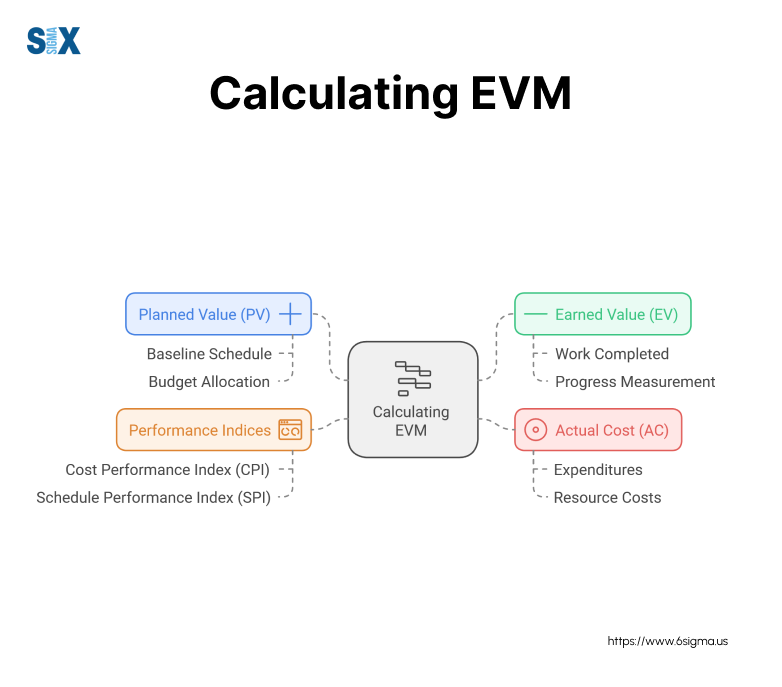
The performance measurement baseline approach, when combined with EVM, provides a powerful toolkit for project managers. It’s not just about tracking numbers; it’s about gaining actionable insights to steer your project toward success.
Dive deeper into Earned Value Management and its application in project control. Our Lean Six Sigma Black Belt course covers advanced project management techniques. Elevate your project management expertise today!
More Techniques for PMB Management
I’ve seen project management evolve dramatically. The Performance Measurement Baseline (PMB) has remained a constant, but how we manage it has transformed. Let me share some advanced techniques I’ve developed and implemented across various industries.
Maintaining and Updating PMB
Change Control Process
In my experience, a robust change control process is crucial for PMB integrity. At Motorola, we implemented a three-tier approval system:
- Minor changes: Approved by project manager
- Moderate changes: Reviewed by change control board
- Major changes: Require executive sponsor approval
This ensured our PMB remained relevant without compromising its value as a benchmark.
Rebaselining Considerations
Rebaselining should be a last resort, but sometimes it’s necessary. When leading a complex R&D project at Intel, we had to rebaseline due to a significant technological breakthrough. Key considerations include:
- Documenting reasons for rebaselining
- Preserving original baseline data for historical analysis
- Communicating changes to all stakeholders
Best Practices for PMB Maintenance
- Regular reviews (I recommend bi-weekly for most projects)
- Version control for all baseline documents
- Integration with risk management processes
PMB in Agile and Hybrid Environments
Adapting PMB for Agile Projects
In today’s fast-paced business environment, agility is key. I’ve successfully adapted PMB concepts for Agile projects by:
- Using rolling wave planning for near-term sprints
- Maintaining a high-level PMB for the overall project
- Focusing on value delivered rather than tasks completed
Integrating PMB with Scrum and Kanban
- Scrum: Align sprint goals with PMB milestones
- Kanban: Use PMB to set WIP limits and identify bottlenecks
Leveraging Technology for PMB
Overview of PMB Features in Popular Project Management Software
Modern tools have revolutionized PMB management. In my workshops, I often demonstrate features like:
- Automated baseline tracking in Microsoft Project
- Real-time collaboration on baselines in Jira
- Visual PMB analytics in Primavera P6
AI and Machine Learning Applications for PMB
The future of PMB is exciting. I’m currently working on integrating machine learning algorithms to:
- Predict potential baseline deviations
- Suggest optimal rebaselining points
- Automate routine PMB maintenance tasks
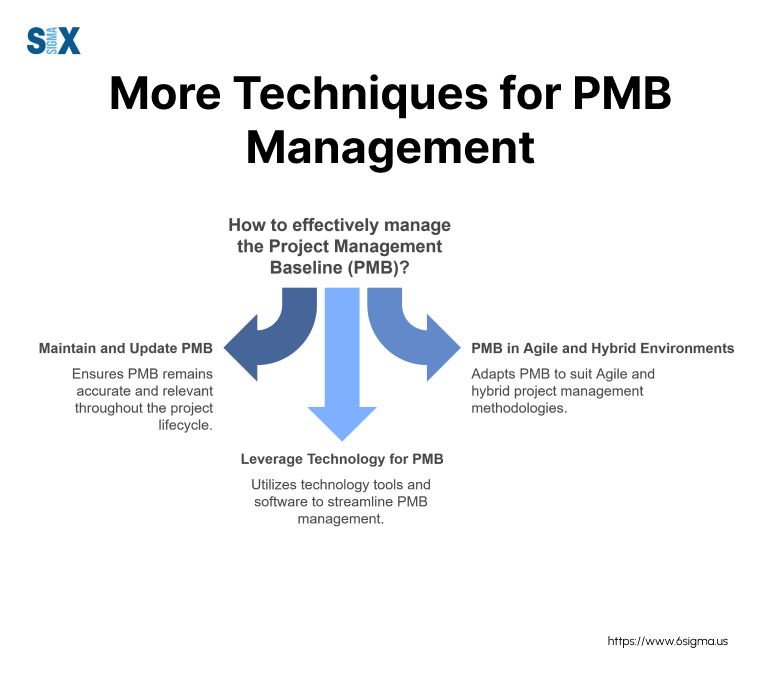
As a performance measurement baseline example, imagine an AI system that can analyze historical project data, current progress, and external factors to suggest PMB adjustments in real-time. This level of intelligent baseline management is no longer science fiction – it’s the cutting edge of project management.
By embracing these advanced techniques, you can transform your PMB from a static document into a dynamic, powerful tool for project success. Remember, the key is to balance rigorous baseline management with the flexibility needed in today’s fast-paced project environments.
Industry-Specific Applications of Performance Measurement Baseline (PMB)
PMBs can be tailored to meet industry-specific needs. Here are some insights on how PMBs are applied in various sectors.
PMB in Construction Projects
Unique considerations for construction PMB
In the construction industry, PMBs face unique challenges due to the physical nature of the work and external factors. When I consulted for a major infrastructure project, we had to consider:
- Weather-related delays
- Material price fluctuations
- Regulatory compliance milestones
Example: Large-scale infrastructure project
During a bridge construction project I oversaw, we implemented a multi-tiered PMB approach:
- Tier 1: Overall project milestones
- Tier 2: Phase-specific baselines (e.g., foundation, superstructure)
- Tier 3: Weekly work package baselines
This structure allowed for precise tracking while maintaining flexibility for unforeseen circumstances. The result? The project was completed 2 months ahead of schedule and 5% under budget.
PMB in IT and Software Development
Adapting PMB for software projects
In the fast-paced world of IT, traditional PMB approaches often need modification. When working with Dell on a major software rollout, we incorporated:
- Agile sprint planning within the overall PMB framework
- Frequent baseline reviews (bi-weekly instead of monthly)
- Story point estimation alongside traditional effort estimates
PMB in a Digital Transformation Project
At a large telecom company, we implemented a hybrid PMB for their digital transformation initiative:
- Core infrastructure: Traditional waterfall PMB
- Customer-facing applications: Agile-adapted PMB with rolling wave planning
This approach allowed for stability in backend development while maintaining flexibility for evolving customer needs. The project saw a 40% increase in customer satisfaction scores upon completion.
PMB in Research and Development
Applying PMB to R&D projects
R&D projects present unique challenges due to their inherent uncertainty. During my tenure at Mining and Manufacturing Company, we developed a flexible PMB approach for R&D:
- Phase-gate PMB: Separate baselines for each research phase
- Risk-adjusted timelines: Incorporating uncertainty into duration estimates
- Value-based milestones: Focusing on potential market impact rather than just technical achievements
Challenges and solutions
- Challenge: Unpredictable breakthroughs
Solution: Implement a rapid rebaselining process for significant discoveries - Challenge: Balancing exploration and project constraints
Solution: Use a dual-track PMB – one for core project deliverables, another for exploratory work - Challenge: Measuring intangible progress
Solution: Develop custom KPIs that capture both tangible outputs and knowledge gained
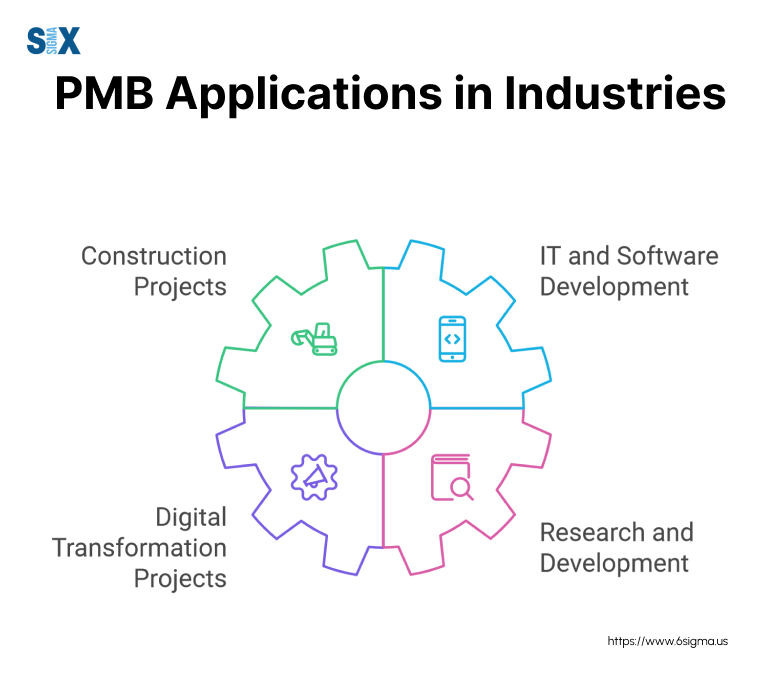
Remember, the key is to maintain the core principles of PMB while adapting to the unique challenges of each industry. This flexibility is what makes PMB such a powerful tool in project management across sectors.
Overcoming Common PMB Challenges
I’ve encountered numerous challenges in implementing and maintaining Performance Measurement Baselines (PMBs). I’ve developed strategies to overcome these hurdles. Let me share some insights on tackling the most common PMB challenges I’ve faced.
Scope Creep and Performance Measurement Baseline (PMB)
Identifying and managing scope changes
Scope creep is one of the biggest threats to PMB integrity. During a large-scale manufacturing project at a consumer electronics manufacturer, we implemented a three-pronged approach:
- Regular scope reviews: Weekly meetings to assess potential scope changes
- Change impact analysis: Evaluating how proposed changes affect the PMB
- Formal change control process: A structured system for approving and documenting changes
Techniques for maintaining PMB integrity
To keep your PMB robust in the face of scope changes, consider:
- Using a rolling wave planning approach for long-term projects
- Implementing a change threshold (e.g., changes impacting less than 2% of total scope don’t require rebaselining)
- Maintaining a separate change log to track cumulative impacts on the PMB
Stakeholder Management and PMB
Communicating PMB to stakeholders
Clear communication is crucial when it comes to baselines in project management. At consumer electronics manufactuer, we developed a stakeholder communication strategy that included:
- Monthly PMB status reports tailored to different stakeholder groups
- Visual dashboards showing PMB performance at a glance
- Quarterly executive briefings on PMB trends and forecasts
Handling conflicting stakeholder expectations
When stakeholders have differing views on PMB, try:
- Conducting stakeholder alignment workshops
- Using data-driven decision-making to resolve conflicts
- Implementing a formal escalation process for unresolved PMB disputes
Resource Allocation and Performance Measurement Baseline (PMB)
Balancing resources across project baselines
Resource allocation can make or break your PMB. During a complex R&D project at Intel, we used:
- Resource leveling techniques to optimize allocation across project phases
- Cross-training programs to increase resource flexibility
- Regular resource capacity reviews aligned with PMB milestones
Strategies for optimal resource utilization
To maximize resource efficiency within your PMB:
- Implement a skills matrix to match tasks with the most suitable resources
- Use predictive analytics to forecast resource needs based on PMB projections
- Establish a resource buffer in your PMB to account for unexpected demands
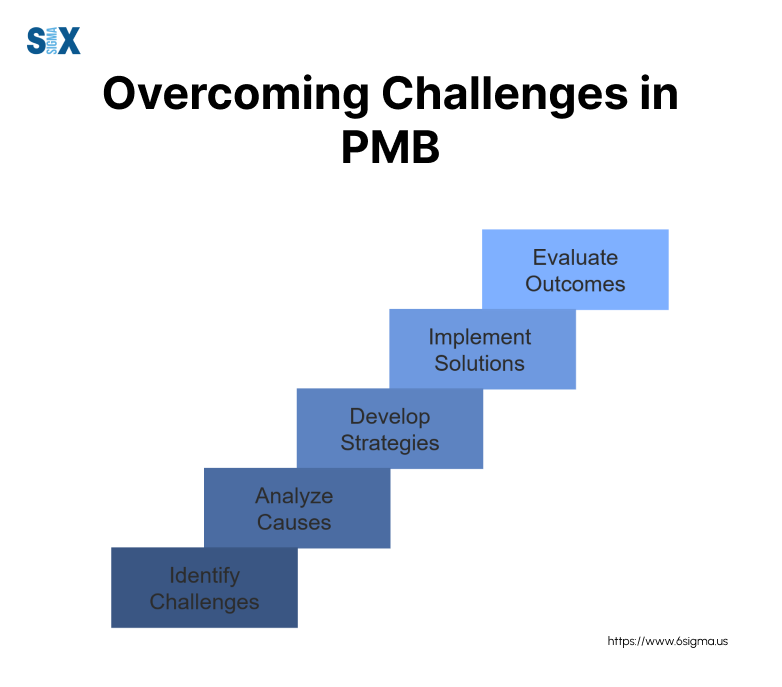
Remember, overcoming these challenges isn’t just about protecting your PMB – it’s about ensuring your project’s success. By proactively addressing scope creep, managing stakeholder expectations, and optimizing resource allocation, you’re setting your project up for smoother execution and better outcomes.
Future Trends in Performance Measurement
I’ve seen the landscape of project management transform dramatically. Let me share my insights on the exciting future trends in performance measurement that are shaping the next generation of PMBs.
AI and Predictive Analytics in PMB (Performance Measurement Baseline)
How AI is shaping the future of project baselines
Artificial Intelligence is revolutionizing how we approach PMBs. In a recent project with a leading tech company, we implemented an AI-driven PMB system that could:
- Automatically adjust baselines based on real-time project data
- Identify potential risks before they impact the project
- Suggest optimal resource allocation strategies
Predictive models for project performance
The future of PMB lies in predictive analytics. I’m currently working on developing models that can:
- Forecast project outcomes with up to 95% accuracy
- Simulate various project scenarios to optimize the PMB
- Provide early warning indicators for potential baseline deviations
Sustainability and PMB
Incorporating sustainability metrics into PMB
As sustainability becomes a key focus for businesses, PMBs are evolving to include environmental and social impact metrics. In my recent workshops, I’ve been teaching project managers how to:
- Integrate carbon footprint measurements into their PMBs
- Track social responsibility KPIs alongside traditional project metrics
- Balance economic, environmental, and social goals within the PMB framework
Case study: Green PMB in an eco-friendly project
I recently consulted on a green building project where we developed a sustainability-focused PMB. This included:
- Energy efficiency milestones
- Waste reduction targets
- Local community engagement metrics
The result? A project that not only met its traditional goals but also achieved LEED Platinum certification.
PMB in Remote and Distributed Teams
Adapting PMB for virtual project environments
The rise of remote work has necessitated changes in how we approach PMBs. Based on my experience leading international projects, I recommend:
- Implementing real-time PMB tracking tools accessible from anywhere
- Focusing on outcome-based metrics rather than activity-based measures
- Increasing the frequency of baseline reviews to account for the rapid changes in virtual environments
Tools and techniques for remote PMB management
To effectively manage PMBs in distributed teams, I’ve found success with:
- Cloud-based project management platforms with integrated PMB features
- Virtual collaboration tools for real-time baseline updates and discussions
- AI-powered productivity tracking to ensure accurate progress reporting against the PMB
As we look to the future, PMBs will continue to evolve, becoming more intelligent, sustainable, and adaptable to our changing work environments. By staying ahead of these trends, project managers can ensure their PMBs remain powerful tools for project success in the years to come.
SixSigma.us offers both Live Virtual classes as well as Online Self-Paced training. Most option includes access to the same great Master Black Belt instructors that teach our World Class in-person sessions. Sign-up today!
Virtual Classroom Training Programs Self-Paced Online Training Programs







